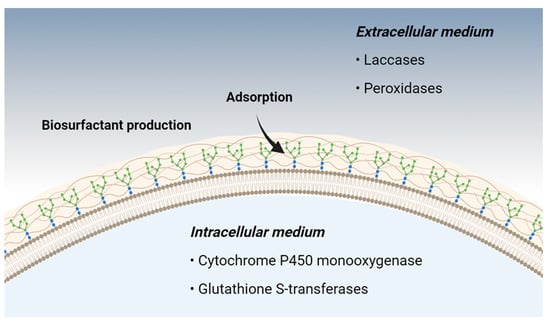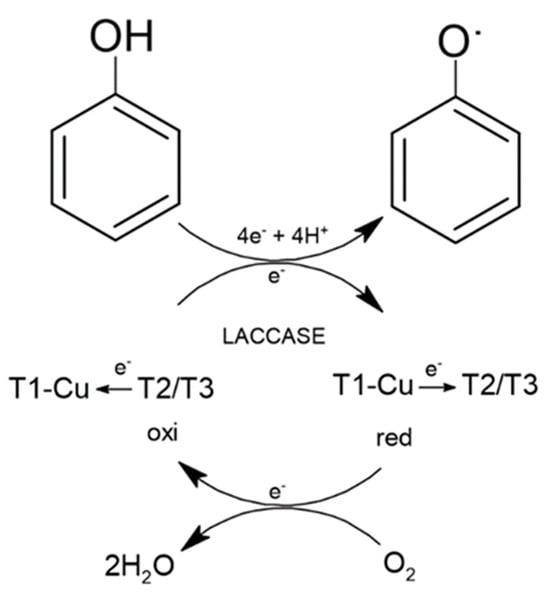You're using an outdated browser. Please upgrade to a modern browser for the best experience.
Please note this is a comparison between Version 1 by Mário Antônio Alves Da Cunha and Version 2 by Wendy Huang.
The industrial sector plays a significant role in global economic growth. However, it also produces polluting effluents that must be treated to prevent environmental damage and ensure the quality of life for future generations is not compromised. Various physical, chemical, and biological methods have been employed to treat industrial effluents. Filamentous fungi, in particular, have garnered attention as effective bioremediation agents due to their ability to produce enzymes capable of degrading recalcitrant compounds, and adsorb different pollutant molecules.
- filamentous fungi
- bioremediation
- industrial effluents
- phenolic compounds
- enzymes
- laccase
1. Introduction
The economic progress and prosperity of a nation is primarily determined by its industrial development. Industries constitute essential elements of modern civilization, supplying vital materials to humankind and creating employment opportunities [1]. Despite the importance of the industrial sector for developing a country, it is essential to note that industries commonly generate a lot of effluent, which can cause environmental damage if discharged into receiving bodies without adequate prior treatment [2].
Industrial effluents are broadly divided into three categories, depending on the type of industry: (a) waste from organic processes (e.g., dairies, chemicals, pharmaceuticals, textiles, foods, and brewing, among others); (b) waste from inorganic processes (chemical and mining industry); and (c) chemical waste (pesticides, herbicides, acids, bases, dyes, fertilizers, pharmaceuticals, among others) [3]. Among the pollutants found in industrial effluents are textile dyes, suspended solids, heavy metals, hydrocarbons, sulfur compounds, chlorinated compounds, fatty acids, surfactants, and phenolic compounds [4]. Phenolic compounds are genotoxic, promote endocrine-disruptive effects, have acute toxicity, and are one of the primary environmental contaminants, especially in water bodies [5]. They can also be released on a smaller scale under natural conditions from decomposing organic matter, but also due to anthropogenic actions by their high use in industry [6]. These compounds are essential in producing chemicals, plastics, oils, pharmaceuticals, dyes, and explosives, among other applications. Consequently, the effluents from these industries exhibit high concentrations of various phenolic compounds [7].
Phenol is the simplest compound in the phenolic family, characterized by a singular aromatic ring and an isolated phenolic hydroxyl group [8]. It presents limited solubility and adsorption to particulate matter. Consequently, the primary modes of transformation for these compounds in the environment involve biodegradation and redox reactions. However, this intricate process can often lead to the formation of compounds that are more environmentally hazardous [9][10][9,10]. Common phenol derivatives with high toxicity and low biodegradability such as chlorophenols, aminophenols, bisphenols, and nitrophenols have been detected in waters [11]. The elevated concentrations of phenolic compounds and their toxic derivatives in the environment induce notable alterations in aquatic biota and microbiota, showing significant risks to human health [12].
In many countries, effluent release into the ecosystem needs to be better regulated. Many industrial effluent treatments could be more efficient, and some treatments are costly, which makes correct disposal by small- and medium-sized industries difficult [3][13][3,13]. In this sense, several organizations are working to develop sustainable industrial effluent treatment technologies [3], and some techniques have been considered effective in removing pollutants from industrial effluents, such as membrane filtration, adsorption, advanced oxidation processes, and bioremediation [14][15][14,15].
Bioremediation is a pollutant cleanup technique focused on biological processes to degrade, reduce, eliminate, modify, detoxify, or transform pollutants into a non-toxic or harmless state [16][17][16,17]. Biological treatment with microorganisms has become a preferred method for treating and reducing toxic organic compounds in industrial effluents [18]. Numerous microorganisms have been recognized for their potential in the removal of phenolic compounds from industrial effluents. These include well-established environmental actors, such as bacteria from the genera Pseudomonas and Bacillus, alongside filamentous fungi, such as Aspergillus, with particular attention to white- and brown-rot fungi [19][20][21][19,20,21].
White- and brown-rot fungi, prevalent in nature, are distinguished for their robust lignin-degrading capabilities [22]. These fungi exhibit resilience and proficiency in degrading various recalcitrant compounds, including phenolic compounds. Their significant production of extracellular enzymes such as peroxidases, laccases, and phenol oxidases enables the effective reduction of phenolic compounds into simpler, less ecotoxic molecules [23][24][25][23,24,25]. Studies have underscored the remarkable potential of white- and brown-rot fungi in phenol reduction, achieving the removal of up to 100% of phenolic forms in industrial effluents [26][27][26,27].
2. Biochemical Mechanisms Involved in Bioremediation Processes with Filamentous Fungi
Filamentous fungi exhibit numerous mechanisms associated with the bioremediation of phenolic compounds, which may be enzymatic or non-enzymatic. Among the primary non-enzymatic mechanisms, adsorption and biosurfactant production are among the best characterized. Enzymatic mechanisms are linked to fungal metabolism, occurring either intracellularly or extracellularly [28][68] (Figure 1).
Figure 1.
Main metabolic pathways used by filamentous fungi in bioremediation.

Figure 2.
Main chemical reactions of laccase.
